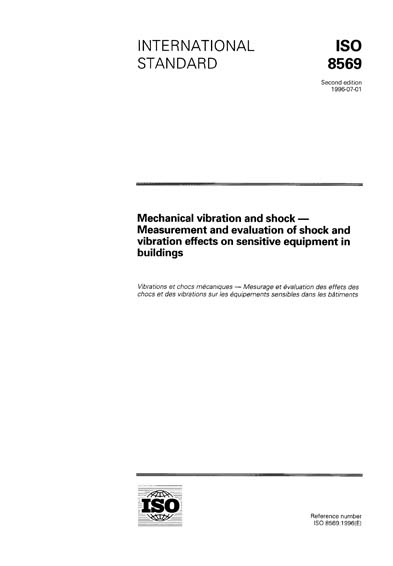Historical
ISO 8569:1996
Mechanical vibration and shock - Measurement and evaluation of shock and vibration effects on sensitive equipment in buildings
This International Standard defines methods of measuring and reporting shock and vibration data for shock- and vibration-sensitive equipment (in operating and non-operating modes) in buildings. The shock and vibration data obtained are used to establish a database.
To facilitate comparison of data (e.g. comparison of shock and vibration levels measured in different countries on equipment from different manufacturers), a database reporting system is discussed. The reporting system presented will aid in the establishment of limiting values for specific equipment and also for classification of their environmental conditions.
The types of shock and vibration considered in this International Standard are those transmitted from floors, tables, walls, ceilings or the isolation system to a unit of equipment. The vibration and shock response of individual mechanical or electronic parts inside the unit are not considered.
The classification system of environmental conditions established from the database should serve as a guide for those who construct, manufacture and use shock- and vibration-sensitive equipment and for building contractors. The types of sensitive equipment envisaged include:
- stationary computer systems (including the peripherals);
- stationary telecommunication equipment;
- stationary laboratory instruments, such as electron microscopes, mass spectrometers, gas chromatographs, lasers and X-ray apparatus of general character;
- mechanical high-precision instruments (tools), such as equipment for microelectronic production;
- optical high-precision instruments, photo-reproduction instruments and E-beams;
- electromechanical systems in train traffic control centres;
- security equipment (fire detection) and equipment for access control.
The types of shock and vibration considered in this International Standard can be generated by:
- external sources (e.g. traffic or building and construction activities such as blasting, piling and vibratory compaction); the vibration response to sonic booms and acoustic excitations is also included;
- equipment for indoor use, such as punch presses, forging hammers, rotary equipment (e.g. air compressors, air-conditioner pumps) and heavy equipment transported or operated inside a building;
- human activities in connection with the service or operation of the equipment;
- natural sources, such as earthquakes, water and wind;
- internal sources; i.e. vibration generated by the equipment itself.
The frequency range of interest is 0,5 Hz to 250 Hz. (The frequency range of interest for earthquake-induced vibration is 0,5 Hz to 35 Hz.) Normally the dominant frequencies are less than 100 Hz, because they represent the response of the elements of the building.
The vibration amplitude and duration depend mainly upon the source, its distance from the sensitive equipment and the response of the elements of the building supporting the sensitive equipment. Expressed in terms of particle velocity, which is the parameter used currently in building vibration evaluation, the values are in the range of 10−4 m/s to 2 × 10−2 m/s.
The vibration values of interest for transient and continuous vibration from different sources are given for information in annex B.
Content Provider
International Organization for Standardization [iso]






